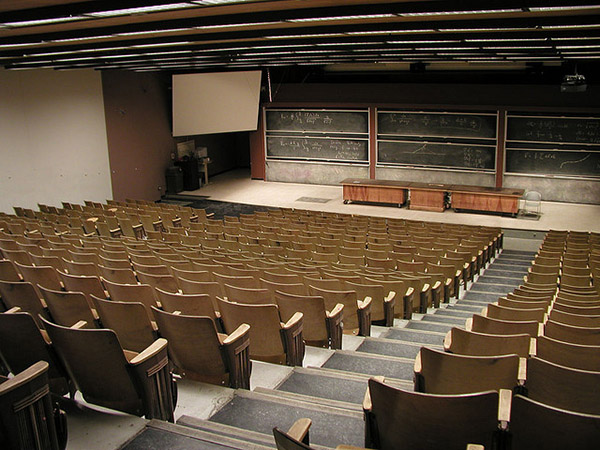Lecture Review – Lawrence Krauss at Concordia and McGill
The talk at Concordia was based on Krauss’ most recent book, Hiding in the Mirror: The Mysterious Allure of Extra Dimensions. Krauss began by giving various examples of humanity’s interest in multiple dimensions such as Edwin A. Abbott’s book Flatland, and some of the art of Pablo Picasso, Marcel Duchamp, and Salvador Dali. Then he moved on to science, giving a short account of physics in the late 19th and 20th centuries. He explained how physicists started trying to explain the fundamental forces as consequences of the geometry of space with extra dimensions, and asked an important question: Where the hell are the extra dimensions?
 As Krauss put it, after a period of speculations about extra dimensions, physics “intervened” with a host of new observations requiring explanation. String theorists resorted to the idea of microscopic strings vibrating in 26 dimensions to explain these, but the phenomena were more successfully accounted for by the theory of quarks, which is fully compatible with a three-dimensional universe. After all of the observations were explained, string theorists, according to Krauss, continued to study things that hadn’t been observed – such as extra spatial dimensions. Krauss ridiculed the outlandish demands string theory makes of the universe without experimental justification.
As Krauss put it, after a period of speculations about extra dimensions, physics “intervened” with a host of new observations requiring explanation. String theorists resorted to the idea of microscopic strings vibrating in 26 dimensions to explain these, but the phenomena were more successfully accounted for by the theory of quarks, which is fully compatible with a three-dimensional universe. After all of the observations were explained, string theorists, according to Krauss, continued to study things that hadn’t been observed – such as extra spatial dimensions. Krauss ridiculed the outlandish demands string theory makes of the universe without experimental justification.
Krauss brought up another trend in modern physics: The anthropic principle. The principle puts physicists in the same position as a hypothetical fish-cosmologist asking why his world is submersed in water. The principle runs like this: The universe is the way it is because if it were not, we would not be here to make any observations of the way it is. Krauss asserts that the anthropic principle is problematic because there is no way to tell what is determined anthropically and what demands a more causal explanation. It forces us to ask whether the laws of physics are fundamental or accidental. To say that the laws of the universe are accidental is to fly in the face of four hundred years of science. Krauss suggests that as we turn to string theory and the anthropic principle, we are moving from the search for a theory of everything to a theory of nothing. There is apparently nothing that these ideas cannot explain; no observation could possibly disagree with their vague and shape-shifting predictions. Krauss concluded the lecture with a lovely phrase of mathematician Hermann Weyl: “My work always tried to unite the true with the beautiful, but when I had to choose one or the other, I usually chose the beautiful.”
Krauss’ lecture at McGill the next day was more technical. He discussed the things that cosmologists expect to happen to the universe in the astronomically distant future, with a slide show featuring a great many equations. Unfortunately, Krauss omitted parts of the presentation in response to the stifling heat in the lecture hall. Krauss explained that when the matter and energy of the universe become too spread out, Hubble expansion, the cosmic microwave background, and other phenomena on which our cosmology has been built will cease to be measurable. Cosmology will end! Moreover, consciousness, purely in the sense of information processing, will be impossible. We live in a very special time: The only time when we can observe that we live in a very special time! This brought Krauss back to the topic of the anthropic principle. He reiterated many of the points from the lecture at Concordia, and added that, so far, the anthropic principle has been wrong every time it has been invoked. Although he omitted any examples he had planned on giving, he said that every time the anthropic principle has been used to explain something, a more compelling explanation from fundamental principles has been found.
Krauss is a talented speaker. He can convey his clear passion for science and crack a lot of nice jokes about string theory and much else in the process. He also gives a fair impression of what it might be like to do work in physics in the coming years. Krauss has a strong understanding of the problems of modern science and can communicate their importance to an audience.
At the reception after the lecture at Concordia, Krauss told someone, “The real books, you should read. Many of them by me!” Some of the books he recommended with great enthusiasm were Edwin Abbott’s Flatland, Henry Manning’s Geometry of Four Dimensions, Richard Feynman’s The Character of Physical Law, and his own Atom.

Comments
No comments posted yet.
You have to be registered and logged in in order to post comments!